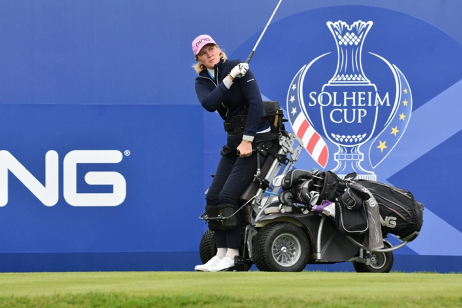Golf, one of the oldest codified sports[1], has for much of the last three centuries had two common entry points; through guidance from a family member, friend or acquaintance, or through informal/formal instruction.[2] A growing body of evidence, however, suggests golf is a health-enhancing physical activity[3], and a way to reduce social isolation, an increasingly recognised risk factor for chronic disease4. Generally played outdoors, in nature, fresh air and green space, golf offers participants the opportunity to develop physically, socially and psychologically. This third entry point of health should be explored further particularly since people with disability are even less active than the non-disabled population.
Golf for the disabled
The acquisition of impairment can have, physical, sensory and mental health impacts, that not only affect everyday life but challenge established norms previously taken for granted[4]. Depending on the nature of impairment, some sports are unable to offer an inclusive environment where disabled and not yet disabled participants can play together and, if desired, undertake meaningful competition[5].
Golf’s cocktail of attributes makes the game accessible for a broad range of participants[6]. Unlike many sports, in golf, the player controls their own ball. The ball is still, which allows a player with impaired movement or vision, and or proprioception issues, to take time to prepare and execute adequately.
Former Paralympic athlete turns to golf

Monique Kalkman has overcome significant challenges. An adolescent Monique determined that she was going to be a “World class athlete”[7]. Years of practice, beating a tennis ball against the garden wall ensued, and then when her hopes and dreams were in touching distance, she faced her biggest challenge. Diagnosed with cancer leading to paraplegia at just 14 years of age, her determination to remain in charge of her destiny, became all encompassing. Refusing to be defined by a disability, Monique vowed to become the athlete she had always dreamed of, albeit one who would compete in a wheelchair. Paralympic gold medals in table tennis and in tennis; the crown of World No:1 for six years, and a place in the Tennis Hall of Fame was her reward[8].
After a decorated career, it was time to retire and start a different type of work. Monique’s commitment led to endless hours at the work desk, and in 2004 she suffered health problems including heart issues. “I wasn’t really taking care of my body; I wasn’t getting the balance right[9].” After an operation and issues with neck dystonia, Monique realised she needed a new sport, and her entry into golf started as therapy[10]. Using a Paragolfer allowed Monique to play from a standing position and helped her fitness, her neck injury[11], and her wellbeing. Her work ethic soon paid off, and today she plays with the same competitive intensity as that 14-year-old used to belt a tennis ball against the wall.
Conclusion
- Golf can provide health enhancing physical activity and social interaction with the wider spectrum of the golfing community.
- Golf is suitable for people with a wide variety of disabilities.
- Golf for the disabled is growing but is not commonly found on the menu of sporting options offered to the newly disabled.
- Golf, the game that has shown itself to be therapeutic, a fun recreational activity, a competitive outlet and even a passion, must better communicate its values so that more people with disability can take advantage of the opportunities it affords.
View Monique’s story at: Monique short story
Read and hear Monique’s story at: Monique profile
Author, Affiliation and Competing Interests:
Tony Bennett – Head of Disability and Inclusion, The International Golf Federation.
President of the European Disabled Golf Association
References:
[1] The International Olympic Committee., (2020)., “Golf” [online] Available from https://www.olympic.org/golf [accessed August 2020]
[2] Bennett, T., (2016) interview data for Ph.D. research
[3] The relationships between golf and health: a scoping review Murray A, et al. Br J Sports Med 2017; 51:12–19.
[4] Holt-Lunstad J, Smith TB, Layton JB. Social relationships and mortality risk: a meta-analytic review. PLoS Med 2010;7:e1000316
[5] Bennett,T., 2018., EDGA Workshops
[6] Bennett,T., 2014., EDGA AGM
[7] Tennis Hall of Fame., 2020., [online] Available from https://www.tennisfame.com/hall-of-famers/inductees/monique-kalkman [accessed August 2020]
[8] GandHcasestudynew3., 2020., [online] Available from https://www.randa.org/en/theranda/initiatives/disabilitygolf [accessed August 2020]
[9] Bennett, T., (2016) interview data.
[10] EDGA (2019). Mulligan – Tough Love and Second Chances.
[11] EDGA Profiles., (2017)., [online] Available from https://www.edgagolf.com/profiles/05-monique-kalkman/ [accessed August 2020]